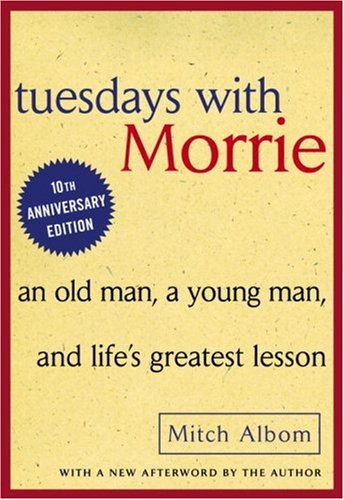All Nonfiction
- Bullying
- Books
- Academic
- Author Interviews
- Celebrity interviews
- College Articles
- College Essays
- Educator of the Year
- Heroes
- Interviews
- Memoir
- Personal Experience
- Sports
- Travel & Culture
All Opinions
- Bullying
- Current Events / Politics
- Discrimination
- Drugs / Alcohol / Smoking
- Entertainment / Celebrities
- Environment
- Love / Relationships
- Movies / Music / TV
- Pop Culture / Trends
- School / College
- Social Issues / Civics
- Spirituality / Religion
- Sports / Hobbies
All Hot Topics
- Bullying
- Community Service
- Environment
- Health
- Letters to the Editor
- Pride & Prejudice
- What Matters
- Back
Summer Guide
- Program Links
- Program Reviews
- Back
College Guide
- College Links
- College Reviews
- College Essays
- College Articles
- Back
Tuesdays with Morrie
Mitch Albom's biography tuesdays with Morrie, recounts the profound yet dwindling moments of Morrie Schwartz's life as he dies of Lou Gherig's disease. From the first passages in the book, Albom grips his readers with the promise of life lessons from Morrie, the best professor of his lifetime. Years after being a college student in Morrie's classes, Mitch and the professor are brought together again because of a national news broadcast. Despite the changes in both of their lives, the two fall easily back into their philosophical relationship and begin to have “class [which] met on Tuesdays… The subject [being] The Meaning of Life. It was taught from experience” (1).
Confined to his home, Morrie has more time to spend pondering life and forming new ways of thinking never before imagined. People diagnosed with terminal illness often accept their impending death and in so doing discover what truly makes life worth living. As Morrie begins the last phase of his life, he realizes that “People see me as a bridge. I'm not as alive as I used to be, but I'm not yet dead. I'm sort of…in-between” (33); therefore, they want advice and contact from him. A new clarity descends upon Morrie, and he can see the importance in living a full life. Over the course of Mitch and Morrie's Tuesdays, Mitch finds that “through his courage, his humor, his patience, and his openness—that Morrie was looking at life from some very different place than anyone else…A healthier…more sensible place” (63). If all of society was to learn from Morrie's remarkable words everyone would be happier and live in great harmony.
Morrie's new-found philosophical clarity is revered by Mitch, as he divulges “I wanted clarity. Every confused and tortured soul I knew wanted that clarity” (66). On his airplane ride back to Chicago, after his first visit with Morrie, Mitch creates a list of topics he wants to discuss with Morrie, like “Death Fear Aging Greed Marriage Family Society Forgiveness [and] A meaningful life” (66). Over the course of their fourteen Tuesdays together, Morrie imparts his wisdom unto Mitch and in turn immortalizes his thoughts in a tape recorder. The set of tapes and memories Mitch made while with Morrie aided his endeavors to create tuesdays with Morrie, which is their “last thesis” together.
Through this book, both Mitch and Morrie wanted to deliver the teacher's dying wisdom to the public. Morrie always wanted the best for everyone, and the way in which he gave to others was by talking to them and communicating with them. Mitch captured the humanity of Morrie's spirit and perception through direct quotation and immaculate imagery. Eager to care for the “one big human family in this world,” Morrie wished for people to “see what they could be” past the “whites and black, Catholics and Protestants, men and women” (156). Morrie gives one solution for seeing past the culture of society and leading a life independent of modern culture's standards.
“You have to work at creating your own subculture,” Morrie taught Mitch and the world. Morrie's personal subculture redefined living. Despite struggling with a crippling disease and impending death, Morrie devoted everyday to delivering his message to all those who would listen. Tuesdays with Morrie has changed the lives of countless readers, and even after the great professor's death, “The teaching goes on” (192).
Similar Articles
JOIN THE DISCUSSION
This article has 0 comments.

